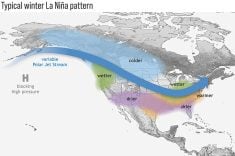Farmers in Western Canada’s rapidly expanding bean industry can have the benefits of a new, narrow-row, direct-cutting system without an increase in weed pressure, according to a recent study by the Agriculture Canada Lethbridge Research Centre.
With new upright bean varieties available, farmers use them in narrow-row production with higher seeding densities, resulting in higher yields and better protection from white mould.
The system eliminates cultivation, so some worry more herbicides may be needed. The study shows that’s not the case.
“We found that the need for herbicides is similar under both the old and new systems, and under certain conditions it may in fact be lower with the new system,” said weed specialist Bob Blackshaw.
Read Also

Canadian Food Inspection Agency extends chronic wasting disease control program consultation deadline
Date extended for consultation period of changes to CWD program
About 90 percent of all bean production in Western Canada is based on traditional vine bean varieties. They require wide rows to allow for undercutting, since many of the vines lie on the surface.
In addition to using herbicides, most producers cultivate between rows at least twice each growing season to control weeds.
Upright bean varieties hold bean pods above the ground, which reduces white mould and eliminates the need for undercutting.
As a result, producers can increase production by planting narrow rows and seeding at higher densities. They also avoid the equipment and labor required for undercutting.
Potentially higher bean yields and improved quality result.
“In the traditional system, if a farmer is considering growing dry beans, he has to go out and buy a specialized planter and an undercutting machine, and either purchase an inter-row cultivator or make some major modifications to his existing one – that’s a lot of expense to first try a new crop,” said Blackshaw.
With the new system, one can use a regular seeder and combine as long as it has a header for direct cutting of low crops.














